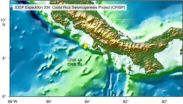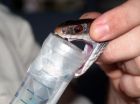(Press-News.org) Northwestern University researchers have provided new biological evidence suggesting that the brain works differently when memorizing the face of a person from one's own race than when memorizing a face from another race.
Their study -- which used EEG recordings to measure brain activity -- sheds light on a well-documented phenomenon known as the "other-race effect." One of the most replicated psychology findings, the other-race effect finds that people are less likely to remember a face from a racial group different from their own.
"Scientists have put forward numerous ideas about why people do not recognize other-race faces as well as same-race faces," says Northwestern psychology professor Ken Paller, who with psychology professor Joan Chiao and Heather Lucas co-authored "Why some faces won't be remembered: Brain potentials illuminate successful versus unsuccessful encoding for same-race and other-race faces."
The discovery of a neural marker of successful encoding of other-race faces will help put these ideas to the test, according to Paller, who directs the Cognitive Neuroscience Laboratory in the Weinberg College of Arts and Sciences.
"The ability to accurately remember faces is an important social skill with potentially serious consequences," says doctoral student Lucas, lead author of the recently published study in Frontiers in Human Neuroscience. "It's merely embarrassing to forget your spouse's boss, but when an eyewitness incorrectly remembers a face, the consequence can be a wrongful criminal conviction," she adds.
The Northwestern team found that brain activity increases in the very first 200 to 250 milliseconds upon seeing both same-race and other-race faces. To their surprise, however, they found that the amplitude of that increased brain activity only predicts whether an other-race face (not a same-race face) is later remembered.
"There appears to be a critical phase shortly after an other-race face appears that determines whether or not that face will be remembered or forgotten," Lucas says. "In other words, the process of laying down a memory begins almost immediately after one first sees the face."
Previous research has associated this very early phase -- what is known as the N200 brain potential -- with the perceptual process of individuation. That process involves identifying personally unique facial features such as the shape of the eyes and nose and the spatial configuration of various facial features.
When the researchers asked the 18 white study participants to view same-race faces and to commit them to memory, the individuation process indexed by N200 appeared "almost automatic -- so robust and reliable that it actually was irrelevant as to whether a face was remembered or not," says Lucas.
Minutes later, the participants were given a recognition test that included new faces along with some that were previously viewed. The researchers analyzed brain activity during initial face viewing as a function of whether or not each face was ultimately remembered or forgotten on the recognition test.
The N200 waves were large for all same-race faces, regardless of whether or not they later were successfully remembered. In contrast, N200 waves were larger for other-race faces that were remembered than for other-race faces that were forgotten.
Of course, not all same-race faces were successfully recognized, the researchers say. Accordingly, their study also identified brain activity that predicted whether or not a same-race face would be remembered. A specific brain wave starting at about 300 milliseconds and lasting for several hundred milliseconds was associated with what the psychologists call "elaborative encoding."
In contrast to individuation (which involves rapidly identifying unique physical attributes from faces), elaborative encoding is a more deliberate process of inferring attributes. For example, you might note that a face reminds you of someone you know, that its expression appears friendly or shy, or it looks like the face of a scientist or police officer.
Making these types of social inferences increases the likelihood that a face will be remembered.
"However, this strategy only works if the process of individuation also occurred successfully -- that is, if the physical attributes unique to a particular face already have been committed to memory," Lucas says. "And our study found that individuation is not always engaged with other-race faces."
Why is individuation so fragile for other-race faces? One possibility, the researchers say, is that many people simply have less practice seeing and remembering other-race faces.
"People tend to have more frequent and extensive interactions with same-race than with other-race individuals, particularly racial majority members," Lucas says. As a result, their brains may be less adept at finding the facial information that distinguishes other-race faces from one another compared to distinguishing among faces of their own racial group.
Another possible explanation involves "social categorization," or the tendency to group others into social categories by race. "Prior research has found that when we label and group others according to race we end up focusing more on attributes that group members tend to have in common -- such as skin color -- and less on attributes that individuate one group member from others," Lucas says.
As a result, smaller N200 brain potentials for other-race faces -- particularly those that were not remembered later -- could indicate that race-specifying features of these faces were given more attention.
The Northwestern researchers expect future research to build on their findings in the continuing effort to better understand the other-race effect. "That research also will need to focus more on face recognition in minorities, given that the bulk of research to date has examined majority-white populations," Lucas says.
INFORMATION:
END
CORVALLIS, Ore. – As homes and cities expand closer to forests and wildlands across the American West, increasing wildfire threats have created an unlikely new phenomena – confidence in government.
Recent studies show that people in neighborhoods adjacent to public forest lands can and do trust natural resource managers to a surprising degree, in part because the risks they face are so severe.
Thousands of acres burn every year, threatening homes, lives and property, and in many groups and areas, the phrase "I'm from the government – trust me" is no longer being used ...
Jumeirah Group, the Dubai-based luxury hotel group and member of Dubai Holding, has celebrated the victory of its global brands ambassador, golfer Rory Mcllory, in the US Open at the Congressional Country Club, Bethesda, Maryland, USA.
Rory McIlroy, 22, led the tournament from start to finish, a feat which had not been achieved since Tiger Woods in 2000. McIlroy finished with a score of 268 which is the lowest score in US Open history and a massive 16 under par.
Executive chairman of Jumeirah Group, Gerald Lawless said: "Rory is truly an inspiration. Since his ...
Puntarenas, Costa Rica – New samples of rock and sediment from the depths of the eastern Pacific Ocean may help explain the cause of large, destructive earthquakes similar to the Tohoku Earthquake that struck Japan in mid-March.
Nearly 1500 meters (almost one mile) of core collected from the ocean floor near the coast of Costa Rica reveal detailed records of approximately 2 million years of tectonic activity along a seismic plate boundary.
The samples were retrieved with the scientific drilling vessel JOIDES Resolution during the recent month-long Integrated Ocean ...
Debenhams has launched its lightest ever t-shirt bra, weighing in at just 48g, as the answer to the perfect everyday bra.
Debenhams head of lingerie buying and design, Sharon Webb commented: "Many women find that the search for a bra that fits, flatters, is comfortable and functional, is as hard as finding the right man.
"Our research showed that many traditional t-shirt bras were quite heavy due to their dense foam structure, which is required to give an invisible fit."
Over 90% of women in wearer trials agreed that the bra felt like a second skin.
Back ...
Panama City, Panama – Integrated Ocean Drilling Program (IODP) Expedition 335 Superfast Spreading Rate Crust 4 recently completed operations in Ocean Drilling Program (ODP) Hole 1256D, a deep scientific borehole that extends more than 1500 meters below the seafloor into the Pacific Ocean's igneous crust – rocks that formed through the cooling and crystallization of magma, and form the basement of the ocean floor.
An international team of scientists led by co-chief scientists Damon Teagle (National Oceanographic Center Southampton, University of Southampton in the UK) ...
Debenhams, the high street store, has revealed that super-sized beach towels, able to occupy extra room on crowded shores and sun loungers are soaring in popularity.
Customers are using them to mark out more territory during holidays, providing a better defence against incursions from rival tourists fighting for space in the most popular resorts.
The new towels are up to 65 per cent bigger than normal, and designed using distinctive, bold, bright colours, making it obvious that the space is already occupied, even when the owner isn't there.
Debenhams spokeswoman, ...
Russell Investments has launched a new dedicated website specifically for retail financial advisers.
The new online portal, available direct from the Russell Investments UK homepage, brings together the most relevant investment information from Russell's extensive range of detailed and unbiased industry analysis and allows financial advisers to cut through the noise to hone in on the topics which are important to them.
Alongside this, advisers will be able to quickly navigate through Russell's tools and investment services which can help them get under the bonnet ...
Researchers from the Australian Venom Research Unit (AVRU) at the University of Melbourne have collaborated with scientists from the University of Papua New Guinea and the University of Costa Rica, to develop new antivenom against the lethal Papuan taipan.
The preclinical studies of this antivenom have been published in the international journal PLoS Neglected Tropical Diseases.
Around 750 people are bitten in PNG each year. PhD candidate David Williams from AVRU, who coordinated the project in PNG, said snakebite is a neglected public health problem compounded by antivenom ...
Prudential has announced that men retiring in 2011 expect to receive 50 per cent more pension income than women, according to new Prudential's Class of 2011 research.
Prudential's Class of 2011 research surveyed people planning to retire this year and found that the retirement income gender gap is GBP6,500. The average woman retiring this year expects an annual income of GBP12,900 compared with an average expected male income of GBP19,400.
There is some good news for women though as the retirement income gender gap has shrunk since last year when Prudential's study ...
The transcription of genes is tightly controlled, with a bewildering array of regulatory DNA sequences interacting with a similarly large number of proteins and other factors to determine which genes are active when and where. Understanding how it all works has challenged countless molecular biologists over the past decades but we are now starting to make significant progress. Even so, we have scarcely begun to understand how the entire complexity evolves to give differences in the size and shape of organisms. Exciting new findings are now reported by the group of David ...


